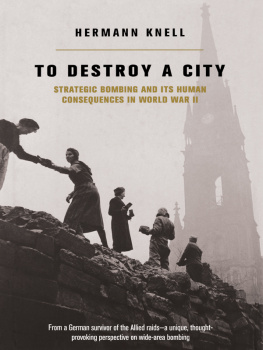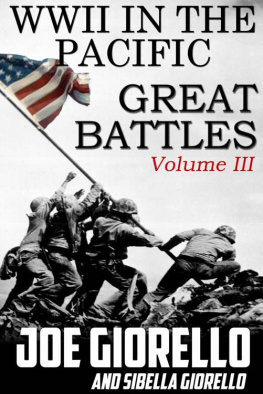
This edition is published by PICKLE PARTNERS PUBLISHINGwww.picklepartnerspublishing.com
To join our mailing list for new titles or for issues with our books picklepublishing@gmail.com
Or on Facebook
Text originally published in 2003 under the same title.
Pickle Partners Publishing 2014, all rights reserved. No part of this publication may be reproduced, stored in a retrieval system or transmitted by any means, electrical, mechanical or otherwise without the written permission of the copyright holder.
Publishers Note
Although in most cases we have retained the Authors original spelling and grammar to authentically reproduce the work of the Author and the original intent of such material, some additional notes and clarifications have been added for the modern readers benefit.
We have also made every effort to include all maps and illustrations of the original edition the limitations of formatting do not allow of including larger maps, we will upload as many of these maps as possible.
DETERMINATION AND EFFECTIVENESS OF WWII STRATEGIC BOMBING STRATEGY
By
Colonel T. Tracey Goetz
TABLE OF CONTENTS
Contents
TABLE OF CONTENTS
REQUEST FROM THE PUBLISHER
ABSTRACT
The Allies chose a strategy utilizing a combination of various military actions, most notably a combined bomber offensive (CBO) to defeat Germany. The CBO was carried out through a combination of US daylight precision and UK night area bombing. The paper will show why the Allies chose this strategy and evaluate its success.
DETERMINATION AND EFFECTIVENESS OF WWII STRATEGIC BOMBING STRATEGY
With the collapse of France in 1940, American (US) and British (UK) leadership became keenly aware that the continued security of their nations required the defeat of the Axis powers, particularly Germany. {1} The Allies chose a strategy utilizing a combination of various military actions, most notably a combined bomber offensive (CBO). The CBO would be carried out through a combination of US daylight precision and UK night area bombing. {2} {3}
The purpose of this paper is to show why the Allies chose this strategy and evaluate its success. To accomplish this task, the paper will first describe the events that brought about the conflict and the strategy. Crowls Questions are used as a framework to analyze the factors that influence strategy development and adoption and will illustrate why Allied leaders chose this path. This is followed by a detailed description of the campaign. The principles of war (mass, objective, offensive, maneuver, surprise, security, simplicity, unity of command, and economy of force) are accepted as proven methods for employing forces in combat and are used to evaluate the CBOs effectiveness {4} The paper closes with a summary of the findings and doctrinal implications.
The paper will show the Allies adopted US daylight precision and UK night area bombing based on leaderships belief that it could most effectively reduce Germanys means of war and hasten its earliest possible defeat. The Allies successfully achieved this objective primarily through adherence to the principles of mass, objective, offensive, and maneuver.
BACKGROUND
EVENTS LEADING TO CONFLICT
Hitler became Chancellor of Germany in 1933 propelled on promises to a disillusioned post-WWI population that he would rebuild Germanys military and lead his country in a series of wars to recover German hegemony. His racially based doctrine held that the rise or fall of civilizations is due to their success or failure in maintaining racial purity. Space, in the form of agriculturally useable land that can only be gained through war, is a prerequisite to racial vitality, and is the fundamental objective in the racial struggle for existence. World peace can come only when one power has attained complete and uncontested supremacy. He felt eastward expansion into Russia would be the easiest due to its weakened state after WWI and the Bolshevik Revolution. But since France would never stand by and watch Germany gain power, a preemptive war with the great enemy would be required prior to annexation of Russian lands. {5} His aggressive rearmament program, begun in 1934, created a superior military force. The air arm was a formidable threat by 1936 and continued to grow (3350 bombers on hand in June 1938 with a production rate of 12 bombers a day). German air power so intimidated England, France, Russia, and Czechoslovakia that they allowed Hitler to place a substantial military presence in the Rhineland in 1936 and annex Austria and Sudetenland in 1938 without intervention. Hitler began territorial expansion in earnest with successive military invasions of Poland (1939), Scandinavia and the Low Countries (1940), and Russia (1941 ). {6} {7}
EVENTS LEADING TO STRATEGY ADOPTION
With the collapse of France in 1940, leadership became keenly aware that the continued security of their nations required combined military action to defeat the Axis powers. {8} Combined planning began in January 1941 (Arcadia Conference) and was documented in American-British Conversations (ABC-1). ABC-1 assumed war would involve Japan and Italy but considered Germany the predominant threat. The overall plan was to wear down German resistance by closing a ring around Axis-held territory and tightening it as fast as resources permit. A Continental invasion by land armies launched from England into France and then on to Germany would provide the final knockout punch. Erosion of German resistance would be accomplished through a combination of naval blockade, Russian Army onslaughts, intensive cultivation of resistance in Nazi-occupied countries, limited Anglo-American offensives with locally superior mobile forces, and a combined strategic bombing offensive. {9} {10}
British aviation doctrine was dominated by its Chief of Staff, General Trenchard, who believed "the aim of the RAF was to break down the means of enemy resistance by attacks on objectives selected as most likely to achieve this end. {11} He felt psychological damage from bombing had more effect than the physical. Victory belongs to the nation that conducts the heaviest bombing offensive to destroy enemy industries and, above all, lower morale. {12} {13} US doctrine, deeply influenced by Brigadier General Mitchell, held that modern nations and their means for supporting war were dependent on an intricate web of public works (water, fuel, electric power, etc.) and industrial, agricultural, and transportation centers. Airpower could most quickly and efficiently destroy this economic web for it can leap over armies and navies and conduct precision attacks on those vital centers. {14} {15}
After the Arcadia Conference, Roosevelt requested an estimate of military production requirements to support the ABC-1 strategy. Rather than offer just requirements, air planners took this opportunity to create and submit AWPD-1, a comprehensive air plan for the defeat of the Axis powers. AWPD-1 delineated their vision of required missions with attendant operational concepts, target lists, and force structure requirements. It held that the primary air mission in Europe would be a bomber offensive aimed at the German economic structure. Targets were selected based on their criticality to German means to wage war (see Table 1).














